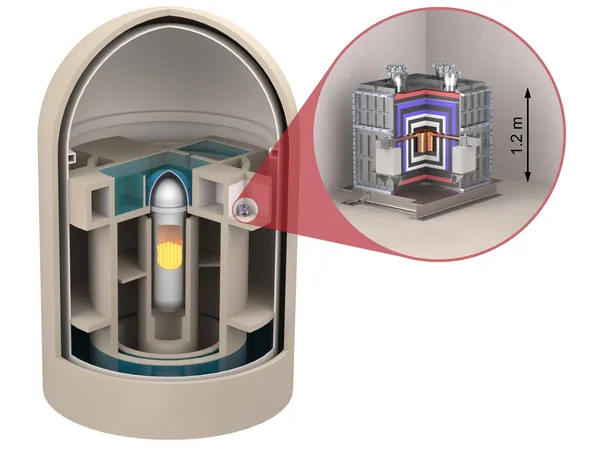
Revolutionary Compact Setup Detects Antineutrinos from Nuclear Reactors!
2025-07-30
Author: Michael
Unveiling the Mysterious World of Antineutrinos
Neutrinos, those minuscule particles that zip through everything, are among the universe's greatest enigmas. Every second, a staggering 60 billion neutrinos from the sun pass through each square centimeter of Earth, remaining completely undetected by most of our scientific instruments. Although theorized decades ago, their existence was only confirmed through large-scale experiments designed to capture their elusive signatures.
A Game-Changer in Detection: The CONUS+ Experiment
Now, scientists from the prestigious Max Planck Institute for Nuclear Physics (MPIK) in Heidelberg have achieved a groundbreaking milestone in particle physics by detecting antineutrinos using the compact CONUS+ experiment. Remarkably, this was achieved with a detector weighing just 3 kilograms, and their findings were published in none other than *Nature*.
From Germany to Switzerland: The Journey of the CONUS Experiment
Originally stationed at the Brokdorf nuclear power plant, the CONUS experiment made its way to the Leibstadt nuclear power plant (KKL) in Switzerland in the summer of 2023. With enhanced germanium semiconductor detectors and optimal measuring conditions at KKL, the team was able to successfully measure a phenomenon known as Coherent Elastic Neutrino-Nucleus Scattering (CEvNS) for the very first time.
How Neutrinos Interact: A Ping-Pong Analogy
In the CEvNS process, neutrinos interact not with individual atoms but with entire atomic nuclei, leading to a significantly increased likelihood of observing nuclear recoils. Imagine a ping-pong ball colliding with a parked car — the resulting movement captures the essence of this delicate interaction.
Revolutionary Measurements at a Nuclear Reactor
The CONUS+ setup, positioned a mere 20.7 meters from the reactor core, traverses an extraordinary environment where more than 10 trillion neutrinos stream through each square centimeter every second. After approximately 119 days of meticulous measurements between fall 2023 and summer 2024, the researchers unearthed an excess of 395±106 neutrino signals — a finding that aligns closely with theoretical predictions.
Potential Applications and the Future of Neutrino Research
Dr. Christian Buck, a key author of the study, expresses pride in confirming the CONUS+ experiment's sensitivity and its capability to detect antineutrino scattering. This opens doors to groundbreaking applications like mobile neutrino detectors that could monitor reactor heat output or isotope concentrations.
A Leap into New Physics Beyond the Standard Model
The CEvNS measurements unravel unique insights into fundamental processes described by the Standard Model of particle physics. The precision achieved with CONUS+ reduces reliance on traditional nuclear physics, enhancing its sensitivity to possible new physics beyond our current understanding.
A Bright Future Ahead for Neutrino Discoveries
In an exciting development, upgraded and larger detectors are already being integrated into the CONUS+ setup for use in autumn 2024. These advancements are expected to yield even more accurate results. Prof. Lindner, the project initiator, highlights the immense potential for groundbreaking discoveries and suggests that these pioneering results could herald a new era in neutrino research.









 Brasil (PT)
Brasil (PT)
 Canada (EN)
Canada (EN)
 Chile (ES)
Chile (ES)
 Česko (CS)
Česko (CS)
 대한민국 (KO)
대한민국 (KO)
 España (ES)
España (ES)
 France (FR)
France (FR)
 Hong Kong (EN)
Hong Kong (EN)
 Italia (IT)
Italia (IT)
 日本 (JA)
日本 (JA)
 Magyarország (HU)
Magyarország (HU)
 Norge (NO)
Norge (NO)
 Polska (PL)
Polska (PL)
 Schweiz (DE)
Schweiz (DE)
 Singapore (EN)
Singapore (EN)
 Sverige (SV)
Sverige (SV)
 Suomi (FI)
Suomi (FI)
 Türkiye (TR)
Türkiye (TR)
 الإمارات العربية المتحدة (AR)
الإمارات العربية المتحدة (AR)